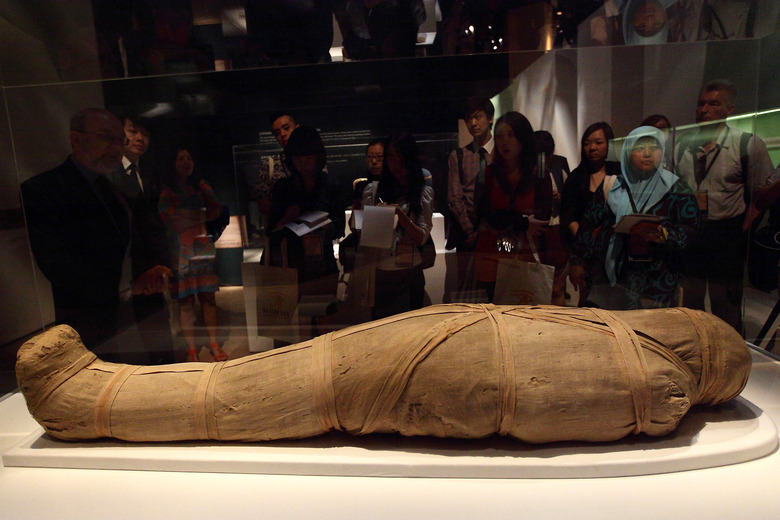Linen In Ancient Egypt
The Nile advanced the civilization of ancient Egypt. The river's annual floods left soil rich enough to feed a large and complex society — and to grow a plant whose fiber was used for all kinds of household, fishing, farming, fashion and funerary necessities. Flax was a major crop in ancient Egypt, and provided the fiber for linen, a refined yet sturdy textile that accompanied an Egyptian throughout life and even after death.
Miracle Fiber
Miracle Fiber
In ancient Egypt, linen production was a labor-intensive process requiring soaking of the flax, beating to separate the fibers, twisting loose fibers together, spinning them into thread, and finally, weaving the threads into cloth. Surviving fragments of cloth dating to about 5000 B.C. indicate the Egyptians were doing this in Neolithic times. Strong, quick to dry and cool to the skin, linen remained the central fiber in Egyptian life long after wool had become widely used by other cultures of the Mediterranean and Near East starting around 2000 B.C. Linen doesn't take dye well and most Egyptian linen kept its natural shade or was bleached white. They knew how to harvest green flax and make green linen from it — green clothing was a status symbol because the color was strongest when new.
Fiber for the Living
Fiber for the Living
The warm climate of ancient Egypt, more humid than the desert land of today, meant little clothing was needed. The poor and slaves made do with coarse linen loincloths and little else. The rich could display their wealth by wearing additional articles. Much ancient Egyptian clothing consisted of fine-woven rectangular pieces draped over or wrapped around the body and often tied in front, as well as tunics, gowns and shirts both with and without sleeves. Linen can be starch-stiffened and pleated, and the Egyptians used these pleats to make garments very form-fitting, seen as worn in images of Egyptian queens. Finer linen might have been smocked, fringed or even edged with colored stripes — effective blue and red dyes were developed, but were costly.
Fiber for the Dead
Fiber for the Dead
We know a lot about ancient Egyptian linen because of examples found in tombs. The very wrappings of mummies themselves were linen strips, soaked in resins and preservatives. Mummy wrappings were not specifically woven for that purpose, but made from recycled sheets and clothing. Other linen textiles have come out of tombs. The tomb of a fairly prosperous woman who lived circa 1500 B.C. yielded three chests that held 76 fringed linen sheets, ranging in length from 14 feet to a coarse-weave, 54-foot-long sheet that might have served as a mattress when folded. The sheets were well worn and some had been mended. They had been washed, pressed and carefully folded for the journey to the afterlife. The grave of a 17-year-old girl of Egypt's Roman period contained a funeral wreath made entirely of bound linen, fibers that would outlast a wreath of fragile flowers.
Fishing Nets and Fillings
Fishing Nets and Fillings
Linen was everywhere in ancient Egypt: bedding, furnishings and sailcloth were made from it, and a wide variety of sacks and bags. Linen cord was knotted into nets that carried ceramic jars, or caught fish or birds. Egyptians made linen slings for hunting birds and small animals. Linen fibers made cords as fine as fishing line and as stout as rope, which was made up of hundreds of threads, each twisted individually. Linen was even used in dentistry — a mummy from the Ptolemaic period of the last few centuries B.C. was found to have suffered a severe case of tooth decay. An ancient dentist had packed a wad of linen, perhaps soaked in a painkilling substance, into a large cavity between two of the patient's teeth as a filling.
References
- British Museum: Linen Garment
- University College London: Digital Egypt for Universities: Textile Production and Clothing
- Yale Peabody Museum: Unwrapped Egyptian Mummy, Female, with Fragments of Linen Wrapping
- The Daily Mail: Dentistry, Ancient Egyptian-Style: Mummy Found with Teeth Stuffed with Linen in Attempt to Cure Agonizing Tooth-ache
- Metropolitan Museum of Art: Gable–Topped Chest and Linens
- Metropolitan Museum of Art: The Housemistress in New Kingdom Egypt: Hatnofer
- British Museum: Linen Wreath of Cleopatra
- British Museum: Strip of Decorated Linen
Cite This Article
MLA
Crawford, Benna. "Linen In Ancient Egypt" sciencing.com, https://www.sciencing.com/linen-ancient-egypt-14424/. 24 April 2017.
APA
Crawford, Benna. (2017, April 24). Linen In Ancient Egypt. sciencing.com. Retrieved from https://www.sciencing.com/linen-ancient-egypt-14424/
Chicago
Crawford, Benna. Linen In Ancient Egypt last modified March 24, 2022. https://www.sciencing.com/linen-ancient-egypt-14424/
